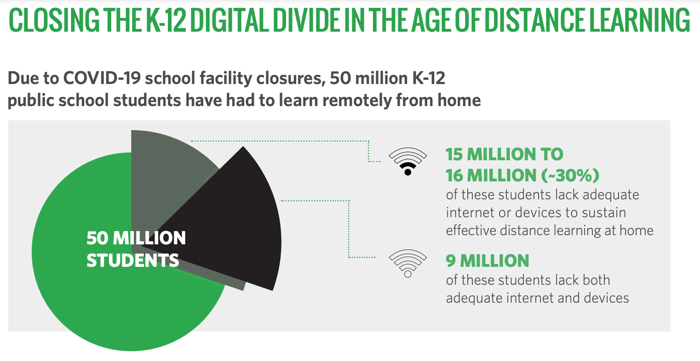Cyberspace, the ‘net, the Information SuperHighway, the World Wide Web, “Jennifer,”: whatever you call it, the internet in the US is firmly embedded in our culture, work, and social time, even more so in the last year.
Even though the internet is a tool to enhance all aspects of life, it is now a critical piece in the education of our youth. Without reliable and accessible internet, students are at risk for learning loss. As a nation, we invite the risk of drastically undereducated children, which then shapes development and achievement difficulties for their futures. Our students deserve so much better, and we need to be their advocates to ensure equity nationwide.
A CommonSense Media analysis called, Closing the K-12 Digital Divide in the Age of Distance Learning found the following:
Chandra, S., Chang, A., Day, L., Fazlullah, A., Liu, J., McBride, L., Mudalige, T., Weiss, D., (2020). Closing the K–12 Digital Divide in the Age of Distance Learning. San Francisco, CA: Common Sense Media. Boston, Massachusetts, Boston Consulting Group.
Here’s a look at additional data points within the report:
- The digital divide exists across the board in all 50 states and corresponding communities but is more visible in rural communities and households with Black, Latinx, and Native American students. Distance learning models have made digital gaps even more visible.
- Approximately 300,000 to 400,000 K-12 teachers do not have reliable internet connectivity, and 10% of teachers do not have adequate home devices.
- It will cost $6 billion and as much as $11 billion in the first 12 months to close this gap for students, and $1 billion to close the gap for teachers.
The task to close the digital gap, is enormous in the effort it requires, and in the finances needed.
So what can we do? Here are a few thoughts:
- While teachers are excellent advocates for their students and plan for a variety of backgrounds and learning needs, it’s important to continue being mindful of how students are able to fully participate in school.
- Call your local and national Representatives and/or Senators. They have the power to make the changes, and call volume increases attention.
- Read
- the linked CommonSense Media report above
- more about students in poverty
- this comprehensive site about the homework gap, and the effort to close it. Read through the recommended resources cited at the end of this post. These resources will shed light on all the aspects of the digital divide, and will help strengthen your advocacy!
There’s hope ahead! Google searches indicate companies like Comcast, T-Mobile, and AT&T, along with Forbes, EducationSuperHighway and FutureReady are bringing awareness and in some cases, creative solutions to address the digital gap. We need to maintain a close watch on this concern to advocate for digital equity- our students and teachers deserve it.
Recommended Resources
Boston Consulting Group. CLOSING THE K–12 DIGITAL DIVIDE IN … – Common Sense Media. CommonSense Media. https://www.commonsensemedia.org/sites/default/files/uploads/pdfs/common_sense_media_report_final_7_1_3pm_web.pdf
Brown, D. (2020, October 28). Closing the ‘Digital Divide’ Critical in COVID-19 Response. Human Rights Watch. https://www.hrw.org/news/2020/03/25/closing-digital-divide-critical-covid-19-response
Commitment to Education. Education. (2021, January 5). https://corporate.comcast.com/education.
The Homework Gap. Center For Rural Affairs – Building a Better Rural Future. (2020, July 15). https://www.cfra.org/publications/homework-gap
Haider, A. The Basic Facts About Children in Poverty. Center for American Progress. https://www.americanprogress.org/issues/poverty/reports/2021/01/12/494506/basic-facts-children-poverty/
Homework Gap: Future Ready. Future Ready iCal. https://futureready.org/homework-gap/
Equitable access. ISTE. https://www.iste.org/standards/essential-conditions/equitable-access
Soul Pancake. (2017). The Homework Gap. YouTube. https://www.youtube.com/watch?v=yqkAlwGsxwE
Startling digital divides in distance learning emerge. UNESCO. (2020, August 10). https://en.unesco.org/news/startling-digital-divides-distance-learning-emerge
The Homework Gap. Center For Rural Affairs – Building a Better Rural Future. (2020, July 15). https://www.cfra.org/publications/homework-gap
Trust, E. (2021, March 8). COVID-19 Education Equity Guide: Digital Access. The Education Trust. https://edtrust.org/resource/covid-19-education-equity-guide-digital-access/







